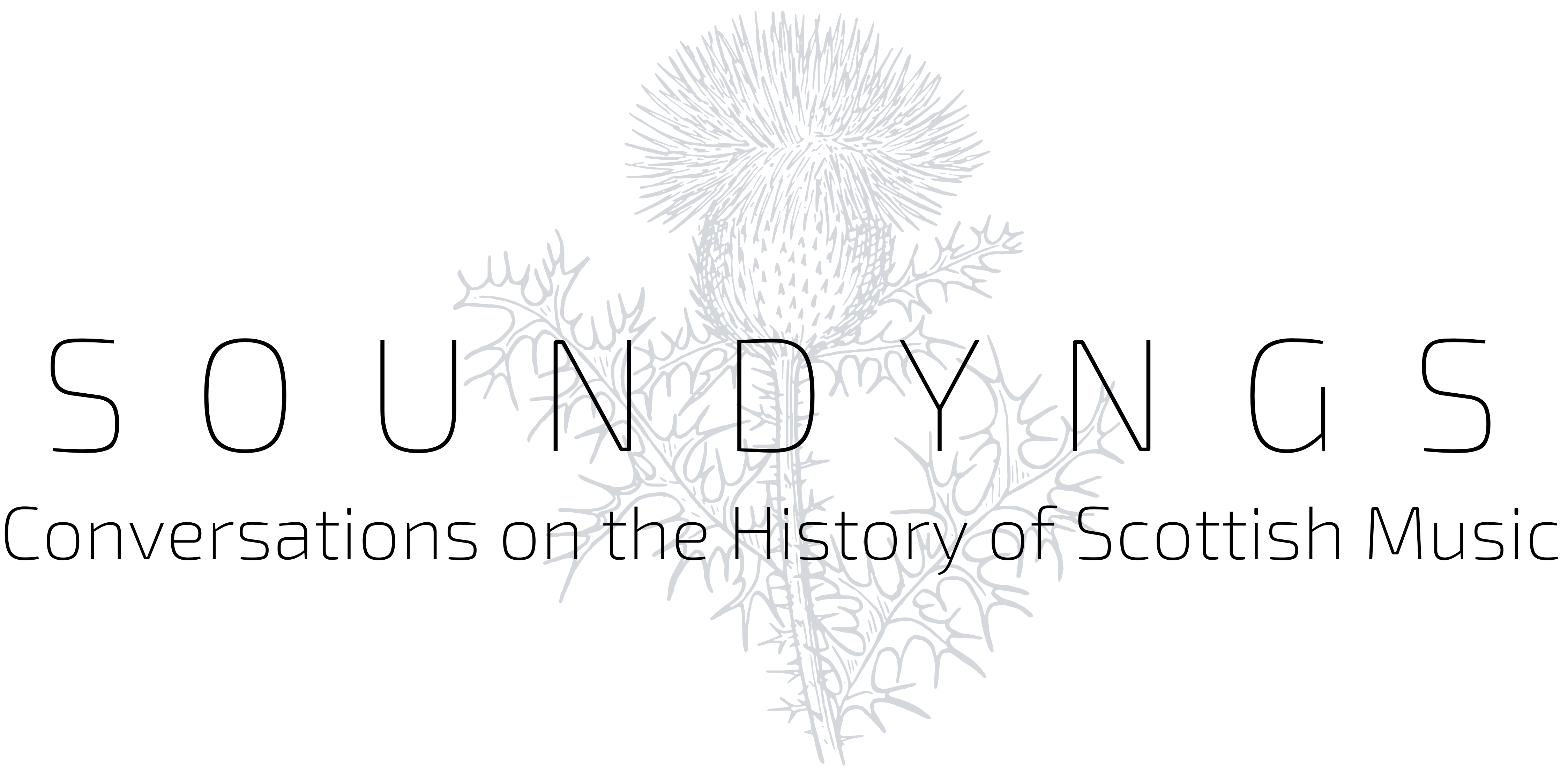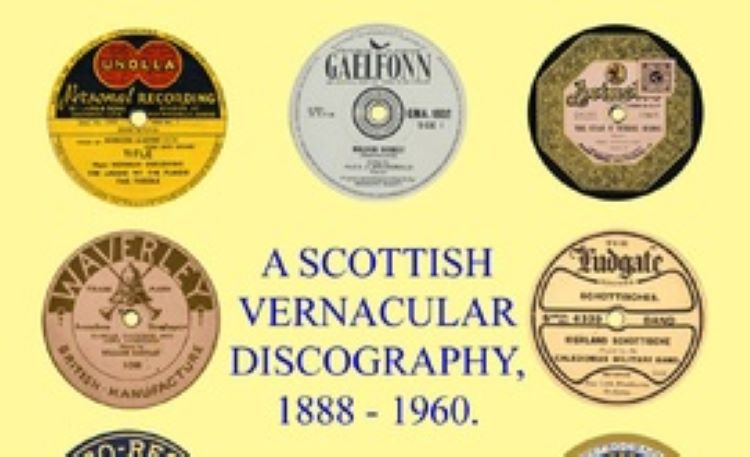Soundyngs was rummaging around in the internet this week and found this resource in the webpages of the National Library of Scotland. Soundyngs isn’t quite sure what to do with it – but thinks it is good to know it exists, and that, maybe, at some point, a researcher better able that it to extrapolate data patterns from this bundle of pdf-formatted chapters into some kind of graphic that reveals more vivid patterns of consumption, might be enouraged to look at this as a “next research step”.
William Dean-Myatt, whose collection forms the core of this list, was from Lichfield, and was essentially a hobbiest known for most of his life as a jazz musician. However, in retirement he embarked on more serious systematic postgraduate study on Scottish Music, and this NLS resource is the outcome of that research. The discography lists recordings of Scottish music made from the earliest periods of electronic recording to 1960, focussing on catalogue information from UK recording labels. The research was also published in book format, currently out of print. The discography also lists on occasion recordings of speech as well as music; records were used in the early days of recording to preserve political speeches by the likes of Lord Aberdeen (1888).
Dean-Myatt’s personal collection of documents and recordings was also donated to the National Library of Scotland after his death in January 2021. Dean-Myatt also produced pamphlets on specific early British record labels, such as Beltona Records, for the City of London Phonograph & Gramophone Society reference series.
While the writing in the introductory pdfs is rather underdeveloped (this is not an academic monograph), Dean-Myatt’s data-collecting impulse was onto something important. Alongside radio, popular record labels such as Beltona (these days part of the Decca group, then an independent label) packaged the sound of Scotland in many recordings to many Scots in the early 20th century, particularly useful to populations who were moving around in ways that might have disrupted older social patterns of localised music performance and listening. Choices of what songs to record, and which singers to feature, must have been an important aspect of national repertoire recognition and curation in Scotland before the mid-century folk revival set out to find and ‘capture’ a different kind of ethnographic recording focussing on hitherto underrepresented singers. Dean-Myatt’s lists, in short, represent the ‘norms’ of how Scottish traditional song might have been understood before the 1950s, before the ethnomusicologists of the folk revival set out to remake and challenge thinking about national and traditional song. Questions of ‘authenticity’ in national identity are always thorny: popular representations, even if these reproduce more obvious material and stereotypes, by dint of their very popularity must have become knitted into the fabric of how many Scots thought of themselves, before the folk revival suggested new approaches.
And these recordings are not just of songs. In a piece written for the online mustrad.org website, Dean-Myatt pointed out that Beltona supplied the newly-founded Scottish Country Dance Society in 1923 with recordings of dance music, presumably for use if live musicians weren’t in the room to accompany a dance class (Dean-Myatt, 2004). In the introduction to the NLS files, Dean-Myatt points out that these early 20th century recordings don’t just preserve music, but also the accents of voices particularly from Aberdeenshire and Glasgow (Dean-Myatt, 2012, ‘Introductions’, p.2). While ethnomusicology collections such as the Smithsonian ‘Folkways’ archives were doubtless collected using more self-consciously academic methods, Dean-Myatt was right in thinking that these more commercial recordings also played a part in representing and archiving music practice in Scotland at a particular point in time. Bothy ballads, for example, were first recorded by Beltona in the 1920s using singers who were not classically-trained professionals (Dean-Myatt, 2012, ‘Introductions’, p.3). Dean-Myatt’s overview suggests that these early labels managed to preserve quite a diverse range of Scottish material – including Gaelic-language material – before a consolidation of the recording industry in the 1940s and 50s led to greater standardisation, a situation that only gradually shifted with the arrival of small independent companies in the 60s and 70s. So perhaps the folk-music revival of the 1950s and 60s might have been a valid push-back against those big-corporate models, but there is some evidence that the material in the recording archives might have been a bit richer than the notion of ‘revival’ might suggest.
Dean-Myatt’s list has an end-date of 1960 because, he suggests, that between the invention of the phonograph and the fragmentation of the market in the modern period, it was possible to curate listings of commercial recordings around a small stable of known recording companies, at least in the UK context, but that from the 1960s the proliferation of independent labels made research of the sort he could do using paper and ring folders increasingly challenging. He acknowledges that his focus on specific catalogues means that earlier non-commercial recordings may be underrepresented in his discographies. The labels listed are dominated by Beltona, but included other names such as Columbia, Parlophone and HMV (His Masters Voice).
The discography is presented in alphabetical order of the lead performer, with contents lists, recording label, country of recording, and release date. Some limited physical information includes whether the recording is single sided or not; if it is a cylinder; and rather oddly, ‘trad’, flagging ‘traditional’. I confess I found it slightly hard to understand the principle upon which the additional keywords had been assigned, as it seemed a bit less than systematic, but possibly that is my ignorance of the field (Dean-Myatt, ‘Abbreviations’, 2012).
A fairly typical entry is illustrated below, relating to Gaelic singer Mina Matheson, recorded in Glasgow sometime in the late 1950s. Gaelfonn was a Glaswegian record label founded specifically for Gaelic language material. According to the National Library of Scotland’s Ceòl nan Gàidheal pages, the label was founded in 1956 by a Lewis man, Murdo Ferguson (NLS, CnG). The NLS CnG site also provides free access to audio samples from this particular company.
MINA MATHESON
Vocal.
Recorded 102 Maxwell Street, Glasgow, ca 1957-60
6307 Sud Mar Chuir Mi’n Geamhradh Tharam ( – ) Gaelfonn GLB-3701
6308 Ho Ri Hi Ro Mo Migheanan (trad) Gaelfonn GLB-3701
In this entry, I assume that the numbers 6307 and 6308 refer to the author’s own cataloguing system, while Gaelfonn GLB-nnnn is the record company’s own catalogue number. Other entries sometimes supply slightly more information about the artist, or alternatively, less; the primary sources are not very clearly shown, but presumbly this often comes from the actual labels on discs, alongside years of reading newspaper and marketing material.
The appendices to the project include an artists’ index, which shows both for soloists and groups their years of recording activity, and an index of record labels, a simple, A-Z list.
Bibliographies and discographies may seem dry to the casual reader, but if you were interested in profiling the singers and musicians involved in Scottish music in the half century before the Scottish folk revival, this list suggests that there was already a lot going on, and that ‘revival’ is a term that needs to be understood in the context of a preexisting and indeed fairly well-established market place for diverse kinds of popular Scottish traditional music recordings. Fair enough, the list shows that certain songs were vastly more frequently performed than others – Robert Burns, for example, features to the point of probable exhaustion. What this raw list needs now is some kind of summary that highlights patterns of significance, explaining what these show about early 20th century Scottish musical culture, and suggesting what implications this has for the dynamics of the mid-century ‘revival’. Some kind of electronic searching might also profile which specific songs were popular when – a kind of trad-top hits – although the pdf format of the NLS documents does not make this particularly easy without further processing. A more rigorous sense of the data sources would also be helpful – but even without this, the lists are a useful snapshot of the music that represented Scots to themselves in the first half of the 20th century.
Further Reading
Ceòl nan Gàidheal – National Library of Scotland, accessed 18th January 2024.
William Dean Myatt, A Draft Scottish Vernacular Discography (2005, 2009, 2012) , (introduction and A-Z separate pdfs, dated 2009, consolidated draft 2012), accessed 19 January 2024
William Dean-Myatt, A Scottish Vernacular Discography, 1888-1960 (CLPGS Reference Series), (City of London Phonograph & Gramophone Society (2013) – see CLPGS webpage – currently out of print
William Dean-Myatt, “Beltona Records and their role in recording Scottish Music”, online article on the non-academic fansite mustrad.org.uk (2004)
Further Listening
Gaelfonn audio tracks – see Ceòl nan Gàidheal

